Environmental Engineering: Solar Power Analysis and Strategies
VerifiedAdded on 2020/03/16
|7
|2524
|323
Report
AI Summary
This report provides a comprehensive overview of solar power, exploring its advantages and disadvantages, and analyzing its scope and potential. It discusses the benefits of solar energy, such as its abundance, cost-effectiveness, and ability to be converted into various forms of energy. The report also addresses the demerits, including high initial installation costs, dependence on weather conditions, and the space requirements for solar panel installation. A SWOT (Strengths, Weaknesses, Opportunities, and Threats) analysis is presented to evaluate the viability of solar energy systems. Furthermore, the report outlines strategies for effective implementation, focusing on cost reduction, minimizing pollution from manufacturing, and enhancing energy storage solutions. The conclusion emphasizes solar power as a promising technology with significant potential, especially in remote areas, despite some existing challenges.
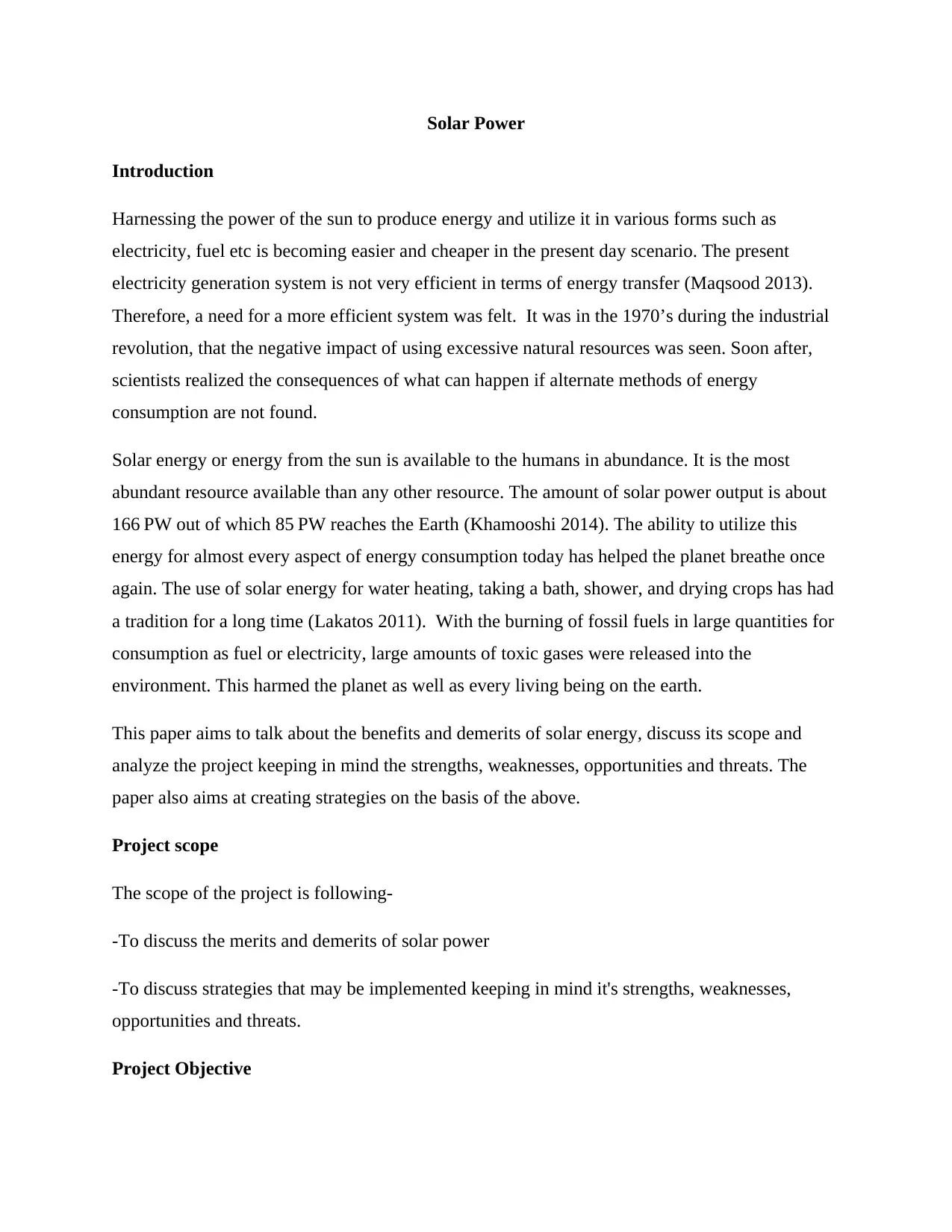
Solar Power
Introduction
Harnessing the power of the sun to produce energy and utilize it in various forms such as
electricity, fuel etc is becoming easier and cheaper in the present day scenario. The present
electricity generation system is not very efficient in terms of energy transfer (Maqsood 2013).
Therefore, a need for a more efficient system was felt. It was in the 1970’s during the industrial
revolution, that the negative impact of using excessive natural resources was seen. Soon after,
scientists realized the consequences of what can happen if alternate methods of energy
consumption are not found.
Solar energy or energy from the sun is available to the humans in abundance. It is the most
abundant resource available than any other resource. The amount of solar power output is about
166 PW out of which 85 PW reaches the Earth (Khamooshi 2014). The ability to utilize this
energy for almost every aspect of energy consumption today has helped the planet breathe once
again. The use of solar energy for water heating, taking a bath, shower, and drying crops has had
a tradition for a long time (Lakatos 2011). With the burning of fossil fuels in large quantities for
consumption as fuel or electricity, large amounts of toxic gases were released into the
environment. This harmed the planet as well as every living being on the earth.
This paper aims to talk about the benefits and demerits of solar energy, discuss its scope and
analyze the project keeping in mind the strengths, weaknesses, opportunities and threats. The
paper also aims at creating strategies on the basis of the above.
Project scope
The scope of the project is following-
-To discuss the merits and demerits of solar power
-To discuss strategies that may be implemented keeping in mind it's strengths, weaknesses,
opportunities and threats.
Project Objective
Introduction
Harnessing the power of the sun to produce energy and utilize it in various forms such as
electricity, fuel etc is becoming easier and cheaper in the present day scenario. The present
electricity generation system is not very efficient in terms of energy transfer (Maqsood 2013).
Therefore, a need for a more efficient system was felt. It was in the 1970’s during the industrial
revolution, that the negative impact of using excessive natural resources was seen. Soon after,
scientists realized the consequences of what can happen if alternate methods of energy
consumption are not found.
Solar energy or energy from the sun is available to the humans in abundance. It is the most
abundant resource available than any other resource. The amount of solar power output is about
166 PW out of which 85 PW reaches the Earth (Khamooshi 2014). The ability to utilize this
energy for almost every aspect of energy consumption today has helped the planet breathe once
again. The use of solar energy for water heating, taking a bath, shower, and drying crops has had
a tradition for a long time (Lakatos 2011). With the burning of fossil fuels in large quantities for
consumption as fuel or electricity, large amounts of toxic gases were released into the
environment. This harmed the planet as well as every living being on the earth.
This paper aims to talk about the benefits and demerits of solar energy, discuss its scope and
analyze the project keeping in mind the strengths, weaknesses, opportunities and threats. The
paper also aims at creating strategies on the basis of the above.
Project scope
The scope of the project is following-
-To discuss the merits and demerits of solar power
-To discuss strategies that may be implemented keeping in mind it's strengths, weaknesses,
opportunities and threats.
Project Objective
Secure Best Marks with AI Grader
Need help grading? Try our AI Grader for instant feedback on your assignments.
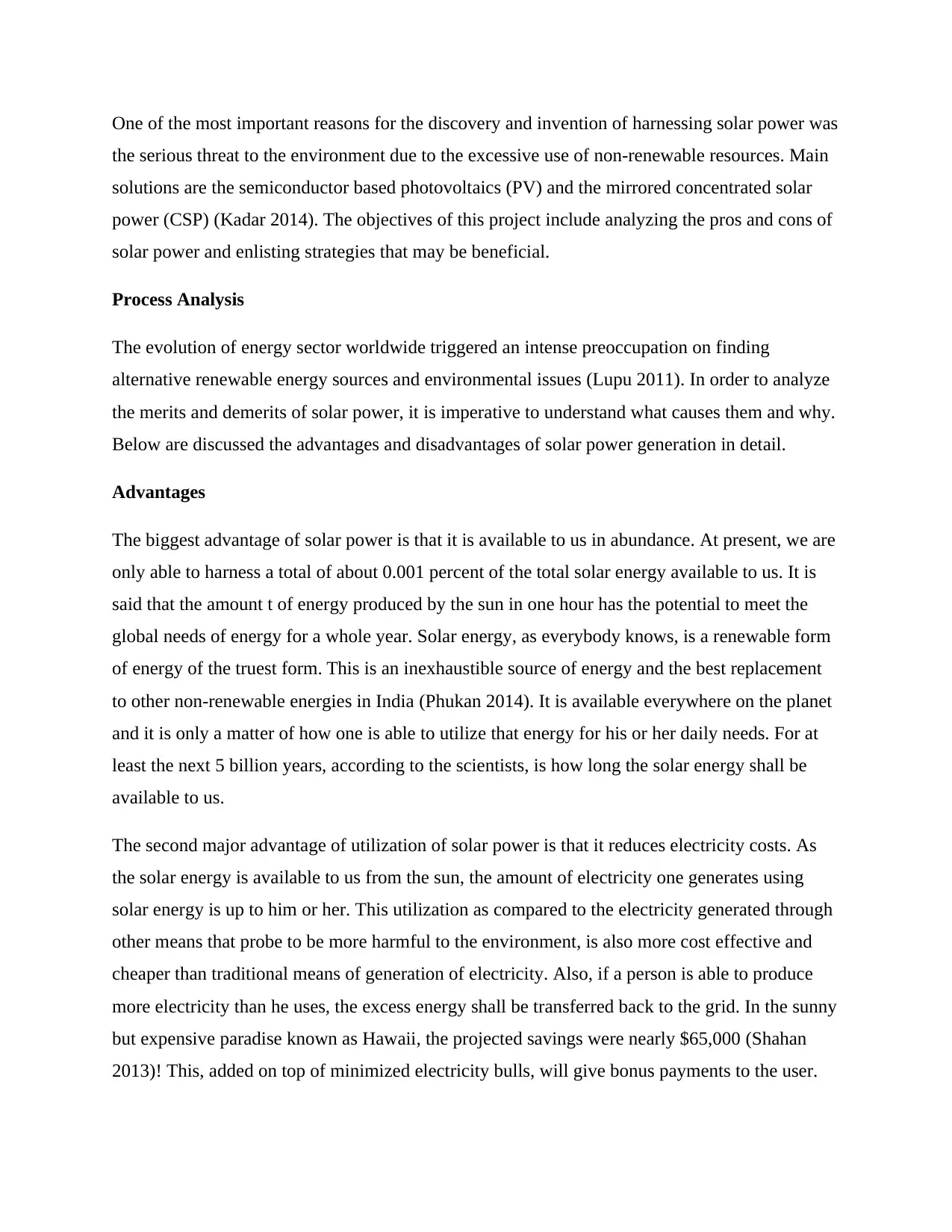
One of the most important reasons for the discovery and invention of harnessing solar power was
the serious threat to the environment due to the excessive use of non-renewable resources. Main
solutions are the semiconductor based photovoltaics (PV) and the mirrored concentrated solar
power (CSP) (Kadar 2014). The objectives of this project include analyzing the pros and cons of
solar power and enlisting strategies that may be beneficial.
Process Analysis
The evolution of energy sector worldwide triggered an intense preoccupation on finding
alternative renewable energy sources and environmental issues (Lupu 2011). In order to analyze
the merits and demerits of solar power, it is imperative to understand what causes them and why.
Below are discussed the advantages and disadvantages of solar power generation in detail.
Advantages
The biggest advantage of solar power is that it is available to us in abundance. At present, we are
only able to harness a total of about 0.001 percent of the total solar energy available to us. It is
said that the amount t of energy produced by the sun in one hour has the potential to meet the
global needs of energy for a whole year. Solar energy, as everybody knows, is a renewable form
of energy of the truest form. This is an inexhaustible source of energy and the best replacement
to other non-renewable energies in India (Phukan 2014). It is available everywhere on the planet
and it is only a matter of how one is able to utilize that energy for his or her daily needs. For at
least the next 5 billion years, according to the scientists, is how long the solar energy shall be
available to us.
The second major advantage of utilization of solar power is that it reduces electricity costs. As
the solar energy is available to us from the sun, the amount of electricity one generates using
solar energy is up to him or her. This utilization as compared to the electricity generated through
other means that probe to be more harmful to the environment, is also more cost effective and
cheaper than traditional means of generation of electricity. Also, if a person is able to produce
more electricity than he uses, the excess energy shall be transferred back to the grid. In the sunny
but expensive paradise known as Hawaii, the projected savings were nearly $65,000 (Shahan
2013)! This, added on top of minimized electricity bulls, will give bonus payments to the user.
the serious threat to the environment due to the excessive use of non-renewable resources. Main
solutions are the semiconductor based photovoltaics (PV) and the mirrored concentrated solar
power (CSP) (Kadar 2014). The objectives of this project include analyzing the pros and cons of
solar power and enlisting strategies that may be beneficial.
Process Analysis
The evolution of energy sector worldwide triggered an intense preoccupation on finding
alternative renewable energy sources and environmental issues (Lupu 2011). In order to analyze
the merits and demerits of solar power, it is imperative to understand what causes them and why.
Below are discussed the advantages and disadvantages of solar power generation in detail.
Advantages
The biggest advantage of solar power is that it is available to us in abundance. At present, we are
only able to harness a total of about 0.001 percent of the total solar energy available to us. It is
said that the amount t of energy produced by the sun in one hour has the potential to meet the
global needs of energy for a whole year. Solar energy, as everybody knows, is a renewable form
of energy of the truest form. This is an inexhaustible source of energy and the best replacement
to other non-renewable energies in India (Phukan 2014). It is available everywhere on the planet
and it is only a matter of how one is able to utilize that energy for his or her daily needs. For at
least the next 5 billion years, according to the scientists, is how long the solar energy shall be
available to us.
The second major advantage of utilization of solar power is that it reduces electricity costs. As
the solar energy is available to us from the sun, the amount of electricity one generates using
solar energy is up to him or her. This utilization as compared to the electricity generated through
other means that probe to be more harmful to the environment, is also more cost effective and
cheaper than traditional means of generation of electricity. Also, if a person is able to produce
more electricity than he uses, the excess energy shall be transferred back to the grid. In the sunny
but expensive paradise known as Hawaii, the projected savings were nearly $65,000 (Shahan
2013)! This, added on top of minimized electricity bulls, will give bonus payments to the user.
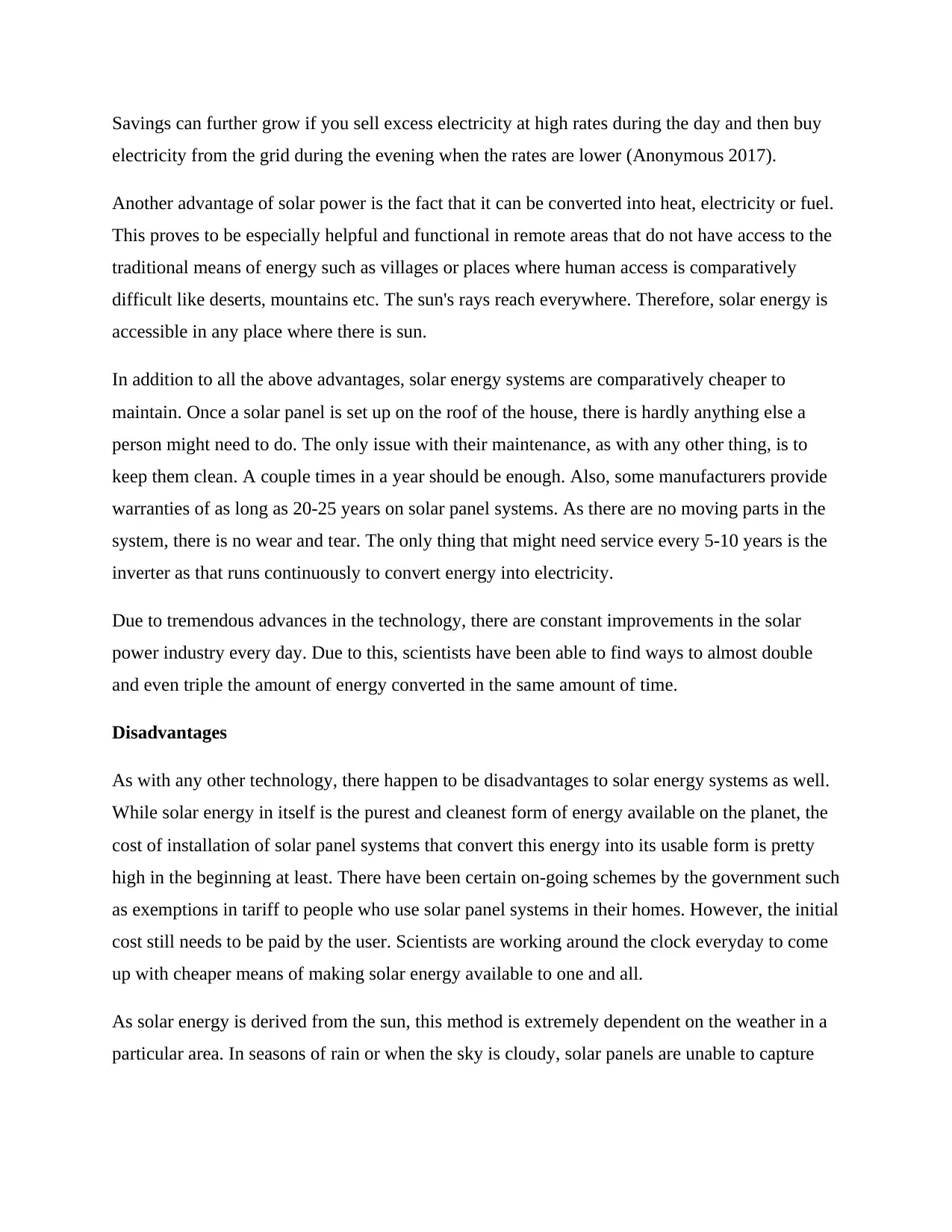
Savings can further grow if you sell excess electricity at high rates during the day and then buy
electricity from the grid during the evening when the rates are lower (Anonymous 2017).
Another advantage of solar power is the fact that it can be converted into heat, electricity or fuel.
This proves to be especially helpful and functional in remote areas that do not have access to the
traditional means of energy such as villages or places where human access is comparatively
difficult like deserts, mountains etc. The sun's rays reach everywhere. Therefore, solar energy is
accessible in any place where there is sun.
In addition to all the above advantages, solar energy systems are comparatively cheaper to
maintain. Once a solar panel is set up on the roof of the house, there is hardly anything else a
person might need to do. The only issue with their maintenance, as with any other thing, is to
keep them clean. A couple times in a year should be enough. Also, some manufacturers provide
warranties of as long as 20-25 years on solar panel systems. As there are no moving parts in the
system, there is no wear and tear. The only thing that might need service every 5-10 years is the
inverter as that runs continuously to convert energy into electricity.
Due to tremendous advances in the technology, there are constant improvements in the solar
power industry every day. Due to this, scientists have been able to find ways to almost double
and even triple the amount of energy converted in the same amount of time.
Disadvantages
As with any other technology, there happen to be disadvantages to solar energy systems as well.
While solar energy in itself is the purest and cleanest form of energy available on the planet, the
cost of installation of solar panel systems that convert this energy into its usable form is pretty
high in the beginning at least. There have been certain on-going schemes by the government such
as exemptions in tariff to people who use solar panel systems in their homes. However, the initial
cost still needs to be paid by the user. Scientists are working around the clock everyday to come
up with cheaper means of making solar energy available to one and all.
As solar energy is derived from the sun, this method is extremely dependent on the weather in a
particular area. In seasons of rain or when the sky is cloudy, solar panels are unable to capture
electricity from the grid during the evening when the rates are lower (Anonymous 2017).
Another advantage of solar power is the fact that it can be converted into heat, electricity or fuel.
This proves to be especially helpful and functional in remote areas that do not have access to the
traditional means of energy such as villages or places where human access is comparatively
difficult like deserts, mountains etc. The sun's rays reach everywhere. Therefore, solar energy is
accessible in any place where there is sun.
In addition to all the above advantages, solar energy systems are comparatively cheaper to
maintain. Once a solar panel is set up on the roof of the house, there is hardly anything else a
person might need to do. The only issue with their maintenance, as with any other thing, is to
keep them clean. A couple times in a year should be enough. Also, some manufacturers provide
warranties of as long as 20-25 years on solar panel systems. As there are no moving parts in the
system, there is no wear and tear. The only thing that might need service every 5-10 years is the
inverter as that runs continuously to convert energy into electricity.
Due to tremendous advances in the technology, there are constant improvements in the solar
power industry every day. Due to this, scientists have been able to find ways to almost double
and even triple the amount of energy converted in the same amount of time.
Disadvantages
As with any other technology, there happen to be disadvantages to solar energy systems as well.
While solar energy in itself is the purest and cleanest form of energy available on the planet, the
cost of installation of solar panel systems that convert this energy into its usable form is pretty
high in the beginning at least. There have been certain on-going schemes by the government such
as exemptions in tariff to people who use solar panel systems in their homes. However, the initial
cost still needs to be paid by the user. Scientists are working around the clock everyday to come
up with cheaper means of making solar energy available to one and all.
As solar energy is derived from the sun, this method is extremely dependent on the weather in a
particular area. In seasons of rain or when the sky is cloudy, solar panels are unable to capture
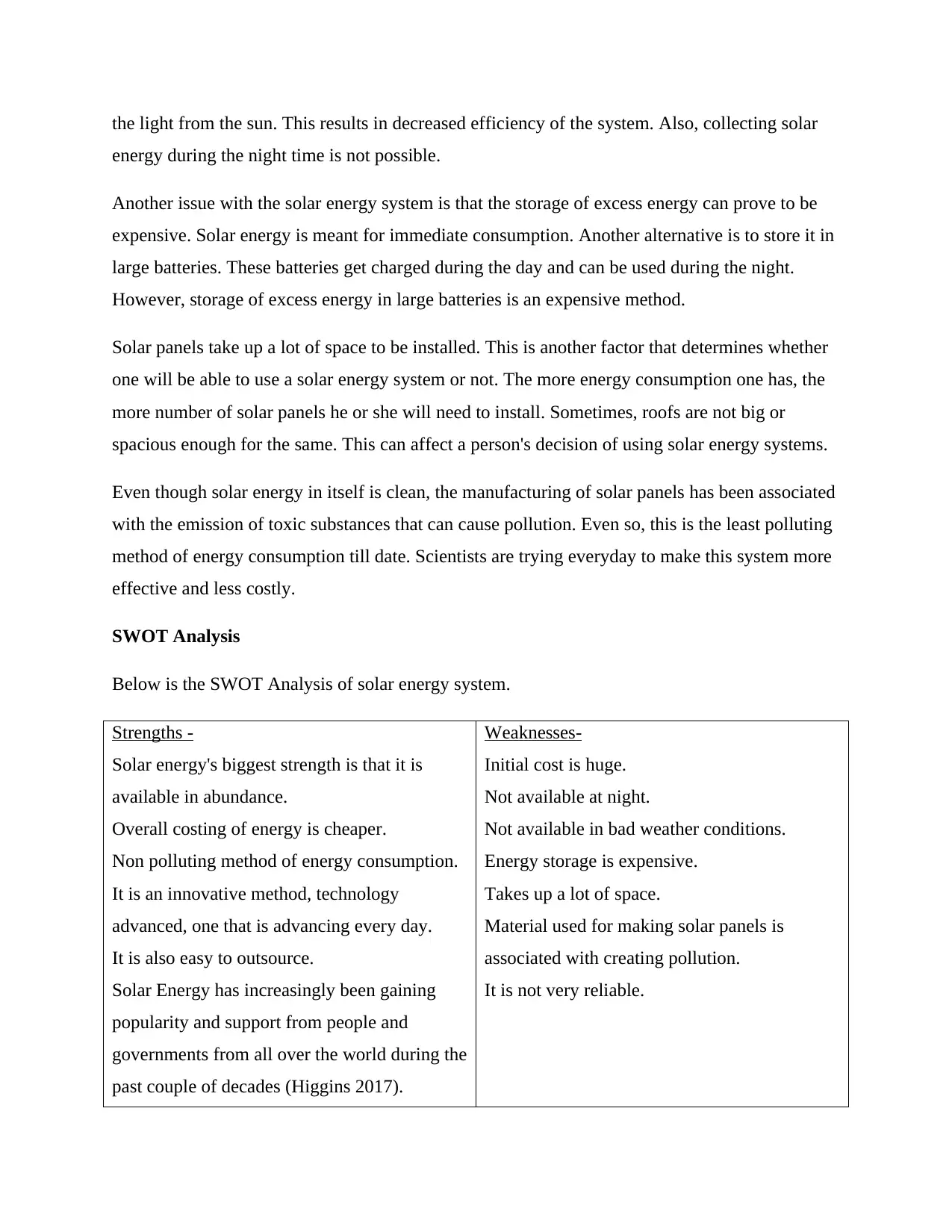
the light from the sun. This results in decreased efficiency of the system. Also, collecting solar
energy during the night time is not possible.
Another issue with the solar energy system is that the storage of excess energy can prove to be
expensive. Solar energy is meant for immediate consumption. Another alternative is to store it in
large batteries. These batteries get charged during the day and can be used during the night.
However, storage of excess energy in large batteries is an expensive method.
Solar panels take up a lot of space to be installed. This is another factor that determines whether
one will be able to use a solar energy system or not. The more energy consumption one has, the
more number of solar panels he or she will need to install. Sometimes, roofs are not big or
spacious enough for the same. This can affect a person's decision of using solar energy systems.
Even though solar energy in itself is clean, the manufacturing of solar panels has been associated
with the emission of toxic substances that can cause pollution. Even so, this is the least polluting
method of energy consumption till date. Scientists are trying everyday to make this system more
effective and less costly.
SWOT Analysis
Below is the SWOT Analysis of solar energy system.
Strengths -
Solar energy's biggest strength is that it is
available in abundance.
Overall costing of energy is cheaper.
Non polluting method of energy consumption.
It is an innovative method, technology
advanced, one that is advancing every day.
It is also easy to outsource.
Solar Energy has increasingly been gaining
popularity and support from people and
governments from all over the world during the
past couple of decades (Higgins 2017).
Weaknesses-
Initial cost is huge.
Not available at night.
Not available in bad weather conditions.
Energy storage is expensive.
Takes up a lot of space.
Material used for making solar panels is
associated with creating pollution.
It is not very reliable.
energy during the night time is not possible.
Another issue with the solar energy system is that the storage of excess energy can prove to be
expensive. Solar energy is meant for immediate consumption. Another alternative is to store it in
large batteries. These batteries get charged during the day and can be used during the night.
However, storage of excess energy in large batteries is an expensive method.
Solar panels take up a lot of space to be installed. This is another factor that determines whether
one will be able to use a solar energy system or not. The more energy consumption one has, the
more number of solar panels he or she will need to install. Sometimes, roofs are not big or
spacious enough for the same. This can affect a person's decision of using solar energy systems.
Even though solar energy in itself is clean, the manufacturing of solar panels has been associated
with the emission of toxic substances that can cause pollution. Even so, this is the least polluting
method of energy consumption till date. Scientists are trying everyday to make this system more
effective and less costly.
SWOT Analysis
Below is the SWOT Analysis of solar energy system.
Strengths -
Solar energy's biggest strength is that it is
available in abundance.
Overall costing of energy is cheaper.
Non polluting method of energy consumption.
It is an innovative method, technology
advanced, one that is advancing every day.
It is also easy to outsource.
Solar Energy has increasingly been gaining
popularity and support from people and
governments from all over the world during the
past couple of decades (Higgins 2017).
Weaknesses-
Initial cost is huge.
Not available at night.
Not available in bad weather conditions.
Energy storage is expensive.
Takes up a lot of space.
Material used for making solar panels is
associated with creating pollution.
It is not very reliable.
Secure Best Marks with AI Grader
Need help grading? Try our AI Grader for instant feedback on your assignments.
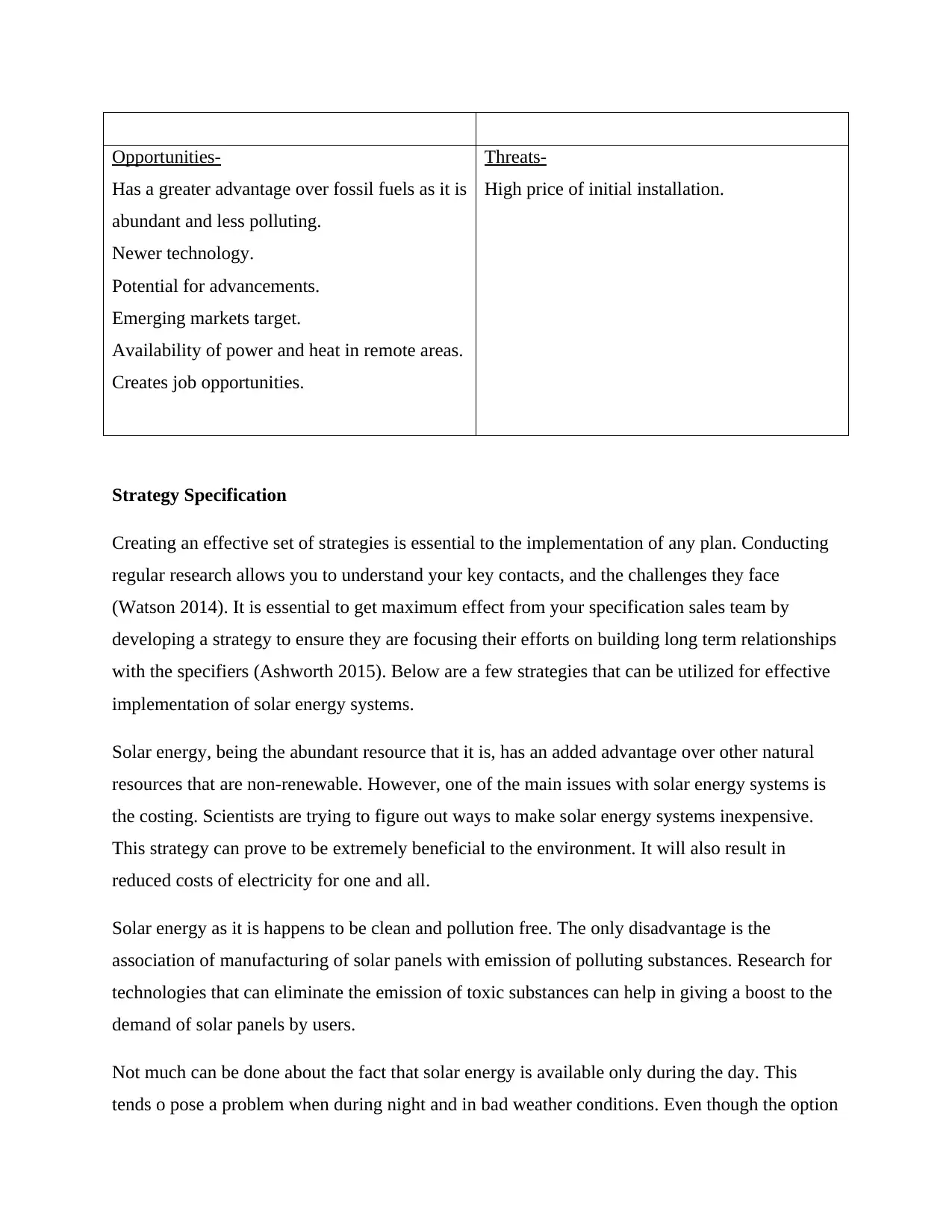
Opportunities-
Has a greater advantage over fossil fuels as it is
abundant and less polluting.
Newer technology.
Potential for advancements.
Emerging markets target.
Availability of power and heat in remote areas.
Creates job opportunities.
Threats-
High price of initial installation.
Strategy Specification
Creating an effective set of strategies is essential to the implementation of any plan. Conducting
regular research allows you to understand your key contacts, and the challenges they face
(Watson 2014). It is essential to get maximum effect from your specification sales team by
developing a strategy to ensure they are focusing their efforts on building long term relationships
with the specifiers (Ashworth 2015). Below are a few strategies that can be utilized for effective
implementation of solar energy systems.
Solar energy, being the abundant resource that it is, has an added advantage over other natural
resources that are non-renewable. However, one of the main issues with solar energy systems is
the costing. Scientists are trying to figure out ways to make solar energy systems inexpensive.
This strategy can prove to be extremely beneficial to the environment. It will also result in
reduced costs of electricity for one and all.
Solar energy as it is happens to be clean and pollution free. The only disadvantage is the
association of manufacturing of solar panels with emission of polluting substances. Research for
technologies that can eliminate the emission of toxic substances can help in giving a boost to the
demand of solar panels by users.
Not much can be done about the fact that solar energy is available only during the day. This
tends o pose a problem when during night and in bad weather conditions. Even though the option
Has a greater advantage over fossil fuels as it is
abundant and less polluting.
Newer technology.
Potential for advancements.
Emerging markets target.
Availability of power and heat in remote areas.
Creates job opportunities.
Threats-
High price of initial installation.
Strategy Specification
Creating an effective set of strategies is essential to the implementation of any plan. Conducting
regular research allows you to understand your key contacts, and the challenges they face
(Watson 2014). It is essential to get maximum effect from your specification sales team by
developing a strategy to ensure they are focusing their efforts on building long term relationships
with the specifiers (Ashworth 2015). Below are a few strategies that can be utilized for effective
implementation of solar energy systems.
Solar energy, being the abundant resource that it is, has an added advantage over other natural
resources that are non-renewable. However, one of the main issues with solar energy systems is
the costing. Scientists are trying to figure out ways to make solar energy systems inexpensive.
This strategy can prove to be extremely beneficial to the environment. It will also result in
reduced costs of electricity for one and all.
Solar energy as it is happens to be clean and pollution free. The only disadvantage is the
association of manufacturing of solar panels with emission of polluting substances. Research for
technologies that can eliminate the emission of toxic substances can help in giving a boost to the
demand of solar panels by users.
Not much can be done about the fact that solar energy is available only during the day. This
tends o pose a problem when during night and in bad weather conditions. Even though the option
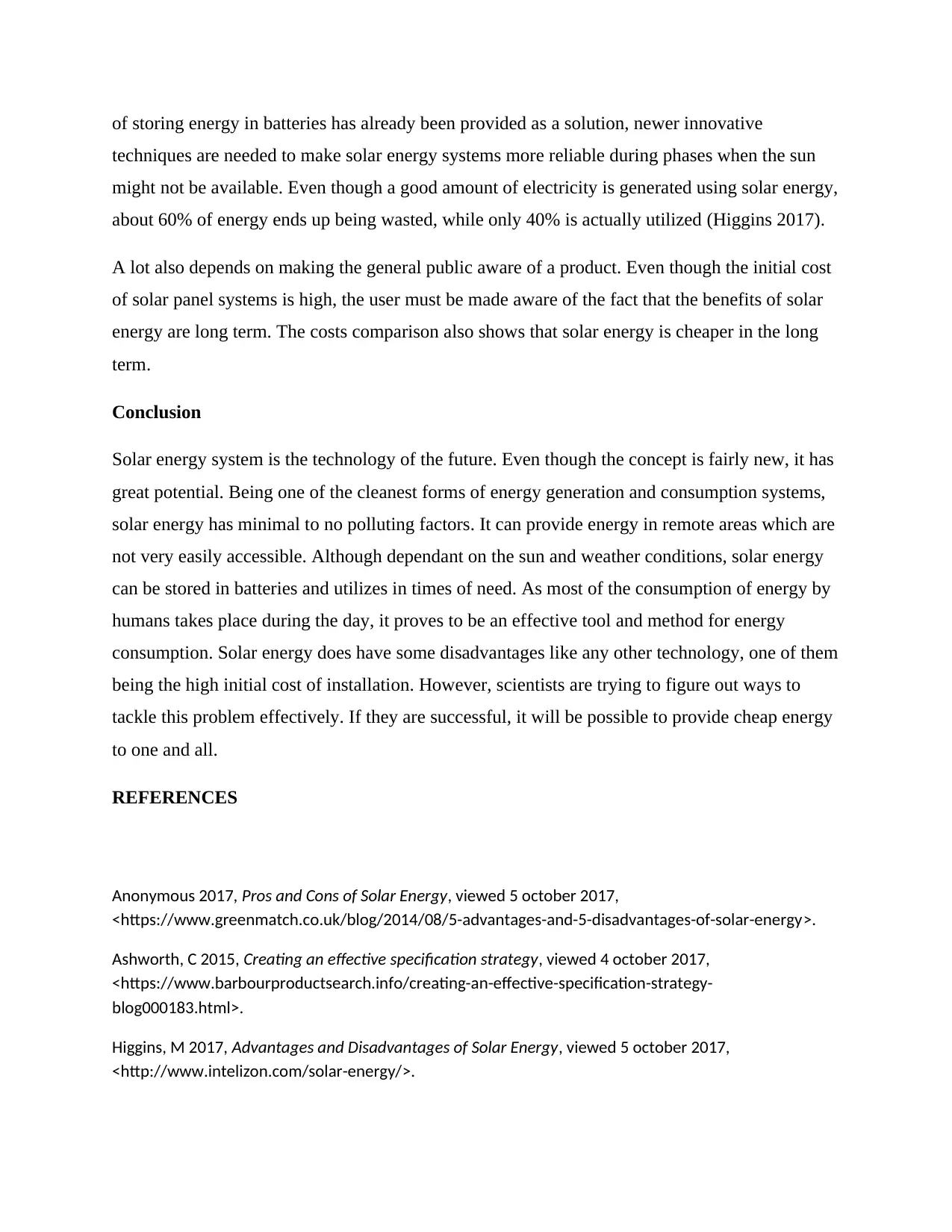
of storing energy in batteries has already been provided as a solution, newer innovative
techniques are needed to make solar energy systems more reliable during phases when the sun
might not be available. Even though a good amount of electricity is generated using solar energy,
about 60% of energy ends up being wasted, while only 40% is actually utilized (Higgins 2017).
A lot also depends on making the general public aware of a product. Even though the initial cost
of solar panel systems is high, the user must be made aware of the fact that the benefits of solar
energy are long term. The costs comparison also shows that solar energy is cheaper in the long
term.
Conclusion
Solar energy system is the technology of the future. Even though the concept is fairly new, it has
great potential. Being one of the cleanest forms of energy generation and consumption systems,
solar energy has minimal to no polluting factors. It can provide energy in remote areas which are
not very easily accessible. Although dependant on the sun and weather conditions, solar energy
can be stored in batteries and utilizes in times of need. As most of the consumption of energy by
humans takes place during the day, it proves to be an effective tool and method for energy
consumption. Solar energy does have some disadvantages like any other technology, one of them
being the high initial cost of installation. However, scientists are trying to figure out ways to
tackle this problem effectively. If they are successful, it will be possible to provide cheap energy
to one and all.
REFERENCES
Anonymous 2017, Pros and Cons of Solar Energy, viewed 5 october 2017,
<https://www.greenmatch.co.uk/blog/2014/08/5-advantages-and-5-disadvantages-of-solar-energy>.
Ashworth, C 2015, Creating an effective specification strategy, viewed 4 october 2017,
<https://www.barbourproductsearch.info/creating-an-effective-specification-strategy-
blog000183.html>.
Higgins, M 2017, Advantages and Disadvantages of Solar Energy, viewed 5 october 2017,
<http://www.intelizon.com/solar-energy/>.
techniques are needed to make solar energy systems more reliable during phases when the sun
might not be available. Even though a good amount of electricity is generated using solar energy,
about 60% of energy ends up being wasted, while only 40% is actually utilized (Higgins 2017).
A lot also depends on making the general public aware of a product. Even though the initial cost
of solar panel systems is high, the user must be made aware of the fact that the benefits of solar
energy are long term. The costs comparison also shows that solar energy is cheaper in the long
term.
Conclusion
Solar energy system is the technology of the future. Even though the concept is fairly new, it has
great potential. Being one of the cleanest forms of energy generation and consumption systems,
solar energy has minimal to no polluting factors. It can provide energy in remote areas which are
not very easily accessible. Although dependant on the sun and weather conditions, solar energy
can be stored in batteries and utilizes in times of need. As most of the consumption of energy by
humans takes place during the day, it proves to be an effective tool and method for energy
consumption. Solar energy does have some disadvantages like any other technology, one of them
being the high initial cost of installation. However, scientists are trying to figure out ways to
tackle this problem effectively. If they are successful, it will be possible to provide cheap energy
to one and all.
REFERENCES
Anonymous 2017, Pros and Cons of Solar Energy, viewed 5 october 2017,
<https://www.greenmatch.co.uk/blog/2014/08/5-advantages-and-5-disadvantages-of-solar-energy>.
Ashworth, C 2015, Creating an effective specification strategy, viewed 4 october 2017,
<https://www.barbourproductsearch.info/creating-an-effective-specification-strategy-
blog000183.html>.
Higgins, M 2017, Advantages and Disadvantages of Solar Energy, viewed 5 october 2017,
<http://www.intelizon.com/solar-energy/>.
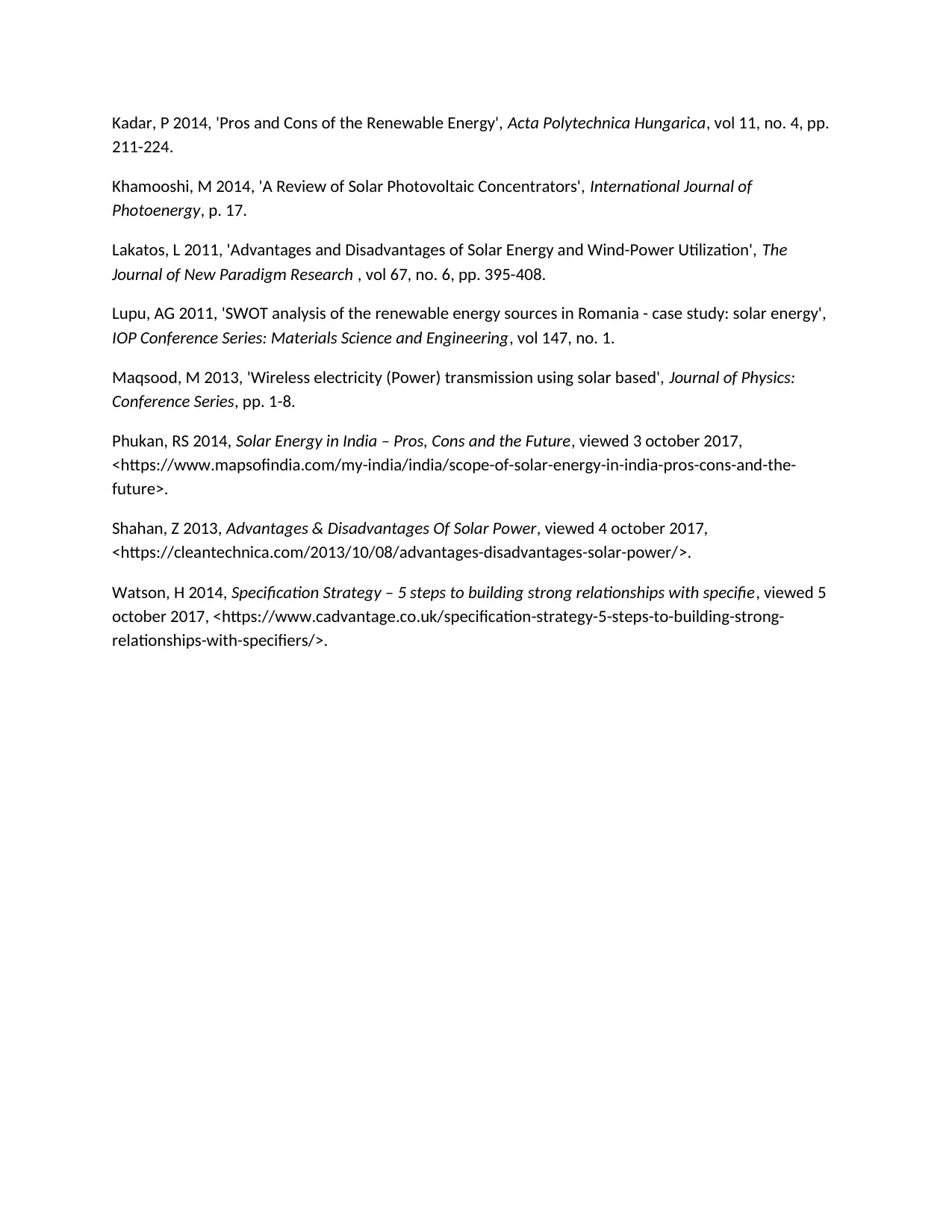
Kadar, P 2014, 'Pros and Cons of the Renewable Energy', Acta Polytechnica Hungarica, vol 11, no. 4, pp.
211-224.
Khamooshi, M 2014, 'A Review of Solar Photovoltaic Concentrators', International Journal of
Photoenergy, p. 17.
Lakatos, L 2011, 'Advantages and Disadvantages of Solar Energy and Wind-Power Utilization', The
Journal of New Paradigm Research , vol 67, no. 6, pp. 395-408.
Lupu, AG 2011, 'SWOT analysis of the renewable energy sources in Romania - case study: solar energy',
IOP Conference Series: Materials Science and Engineering, vol 147, no. 1.
Maqsood, M 2013, 'Wireless electricity (Power) transmission using solar based', Journal of Physics:
Conference Series, pp. 1-8.
Phukan, RS 2014, Solar Energy in India – Pros, Cons and the Future, viewed 3 october 2017,
<https://www.mapsofindia.com/my-india/india/scope-of-solar-energy-in-india-pros-cons-and-the-
future>.
Shahan, Z 2013, Advantages & Disadvantages Of Solar Power, viewed 4 october 2017,
<https://cleantechnica.com/2013/10/08/advantages-disadvantages-solar-power/>.
Watson, H 2014, Specification Strategy – 5 steps to building strong relationships with specifie, viewed 5
october 2017, <https://www.cadvantage.co.uk/specification-strategy-5-steps-to-building-strong-
relationships-with-specifiers/>.
211-224.
Khamooshi, M 2014, 'A Review of Solar Photovoltaic Concentrators', International Journal of
Photoenergy, p. 17.
Lakatos, L 2011, 'Advantages and Disadvantages of Solar Energy and Wind-Power Utilization', The
Journal of New Paradigm Research , vol 67, no. 6, pp. 395-408.
Lupu, AG 2011, 'SWOT analysis of the renewable energy sources in Romania - case study: solar energy',
IOP Conference Series: Materials Science and Engineering, vol 147, no. 1.
Maqsood, M 2013, 'Wireless electricity (Power) transmission using solar based', Journal of Physics:
Conference Series, pp. 1-8.
Phukan, RS 2014, Solar Energy in India – Pros, Cons and the Future, viewed 3 october 2017,
<https://www.mapsofindia.com/my-india/india/scope-of-solar-energy-in-india-pros-cons-and-the-
future>.
Shahan, Z 2013, Advantages & Disadvantages Of Solar Power, viewed 4 october 2017,
<https://cleantechnica.com/2013/10/08/advantages-disadvantages-solar-power/>.
Watson, H 2014, Specification Strategy – 5 steps to building strong relationships with specifie, viewed 5
october 2017, <https://www.cadvantage.co.uk/specification-strategy-5-steps-to-building-strong-
relationships-with-specifiers/>.
1 out of 7
Related Documents
Your All-in-One AI-Powered Toolkit for Academic Success.
+13062052269
info@desklib.com
Available 24*7 on WhatsApp / Email
![[object Object]](/_next/static/media/star-bottom.7253800d.svg)
Unlock your academic potential
© 2024 | Zucol Services PVT LTD | All rights reserved.





